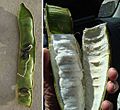Inga feuilleei facts for kids
Quick facts for kids Inga feuilleei |
|
|---|---|
 |
|
| Leaves and fruits | |
| Scientific classification | |
| Genus: |
Inga
|
| Species: |
feuilleei
|
| Synonyms | |
|
|
Inga feuilleei is a tree often called pacay or the ice-cream bean tree. It got its name from Louis Feuillée. This tree grows naturally in the Andean valleys of northwestern South America. Like other trees in the Inga family, pacay trees grow pods with a yummy white pulp inside. Their roots also help the soil by adding important nutrients.
Contents
What is the Ice-Cream Bean Tree Like?
The pacay tree is a medium to large tree. It can grow up to 18 m (59 ft) (about 60 feet) tall! Its young branches, leaf stems, and flowers have tiny, rusty-colored hairs. The leaves usually have 3 to 5 pairs of long, oval-shaped leaflets. The leaflet at the very end can be about 10 to 20 centimeters long.
The flowers grow in spikes that are about 3 centimeters long. The pods are flat and can be 20 centimeters (about 8 inches) long or even longer.
Why is it Called "Ice-Cream Bean"?
People call them "ice-cream beans" because the pulp inside the pods is sweet and smooth, just like ice cream!
How Does it Help the Earth?
Inga trees are amazing because their roots have special bumps called nodules. These nodules help "fix" nitrogen from the air into the soil. This means they add important nutrients to the soil instead of taking them away. This makes the soil healthier and better for other plants to grow.
Pacay trees can handle warm temperatures, up to 30 degrees Celsius (86 degrees Fahrenheit) when they are fully grown. However, cold temperatures can hurt them. They often grow near rivers, so they usually have enough water all year round.
Why are These Trees So Useful?
Inga trees are very reliable. They produce lots of fruit and can provide food even when times are tough. Families can grow food from these trees without using up their main farmland, because the trees can grow in places that are not good for other crops.
They grow quickly, can live in different types of soil, and are strong against diseases and fire. These trees are easy to plant, quickly provide shade, and give fruit for many years.
The fruits are very tasty and are often eaten by people in the areas where they grow. For example, in Mexico, workers on coffee farms can earn extra money by selling the pods from the Inga trees that shade the coffee plants. In Central America, people cook and eat the seeds like vegetables. In Mexico, sometimes the seeds are roasted and sold as snacks outside movie theaters! In Costa Rica, the fruit is called Guaba, and people think it brings good luck.
Gallery
The Future of Pacay Trees
Pacay and other Inga trees have a very important future. They are "multipurpose" trees, meaning they are useful for many things. They can be great additions to gardens, orchards, farms, hedges, or even empty land in warm parts of the world. They also have a lot of potential as city trees in tropical areas. They can be a source of snacks for people who own them and a way for clever people to earn money.
Images for kids
-
An ancient pot from the Moche culture shaped like a pacay pod.
See also
 In Spanish: Pacay para niños
In Spanish: Pacay para niños







